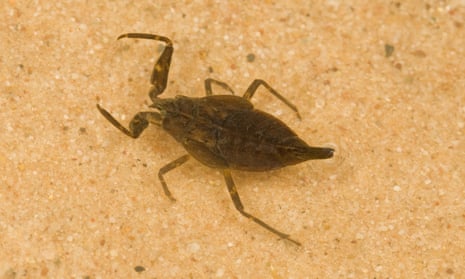I reach into the tepid, brackish pond, right up to my shoulder. My daughter crouches next to me, hoping I will find her a pond snail shell. Eventually, in the squishy mud, I discover an uninhabited one. It’s small and a little cracked but beautifully whirled. Now we part the duckweed with nets, swishing in a figure of eight, then emptying our haul into a clear tub. A dragonfly nymph eyes us like a soggy grasshopper while a water boatman sculls to hide.
There among the diverse creatures is a brown, flattened insect, only one centimetre long but with grasping scorpion pincers and a sharp prong of a tail. “Will it sting me?” Annie asks, watching it suspiciously in her net. This is the water scorpion Nepa cinerea, luckily stingless and no relation to actual scorpions but equally ferocious in behaviour. They are known as “toe-biters” as they will pinch unsuspecting paddlers, although they normally feed upon small fish, tadpoles and other pond insects. Those pincers grip the prey while their powerful mouth parts suck the victim dry.
Like a water boatman or great diving beetle, the water scorpion breathes by absorbing air through its abdomen, where a pearly bubble is trapped by tiny hairs. But it goes one step further. That long tail is in fact a breathing tube. “Look, Annie,” I say, “it breathes through its bum.” It uses that tail like a snorkel to refill the oxygen in the balloon of air by breaking the surface of the water, while its owner remains hidden from threats above. In winter, when ice prevents water scorpions from reaching air, their metabolism drops so significantly that oxygen exchange provides them with enough to survive.
For aquatic creatures, they are terrible swimmers, and prefer to cling motionless to a plant or twig near the surface, periodically reaching up with their behinds to replenish the air supply. They rely on stealth, not speed, to catch dinner.
My back is aching and I realise we’ve passed a whole hour intensely focused on this fascinating ecosystem. Time to return to the real world.
Follow Country diary on Twitter: @gdncountrydiary

Comments (…)
Sign in or create your Guardian account to join the discussion